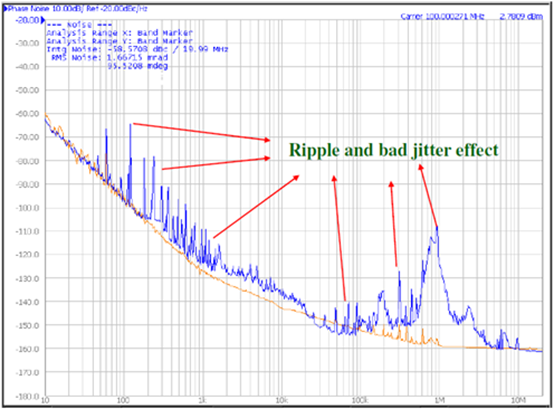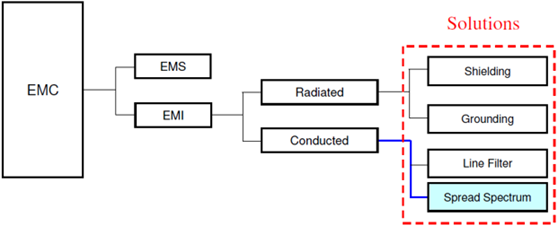Electromagnetic interference (EMI) is pervasive. It is a phenomenon that occurs when the operation of an electronic device is disturbed by an electromagnetic field or conducted power source, resulting in the disruption of the radio frequency spectrum. EMI can damage precision circuits, increase noise and degrade oscillator stability. The effects of EMI can range from merely diminishing circuit performance to causing complete system failure. Figure 1 demonstrates the effects of EMI from a power device.

The presence of electronic signals inevitably generates EMI in electronic circuits. Excessive EMI can interfere with nearby electronic devices. EMI shielding can be used to create a barrier that prevents interference with sensitive devices and signals. While traditional shielding techniques are effective, they often increase the circuit board area, weight and cost, making them less suitable for today’s sleek and compact electronic products. Using RLC component filters to reduce rise/fall time can also be effective, but they impact signal integrity. This causes eye pattern closure and the receiver’s ability to distinguish signals. This leads to bit error rate increases. As transmission interface speeds increase, the effects of EMI become more pronounced, gradually emerging as an important consideration in circuit design. Consequently, reducing EMI is a crucial issue that engineers must address.

EMI violations generally refer to situations where energy is concentrated in a particular frequency band, resulting in higher peaks. Spread Spectrum Clock (SSC) is a widely used EMI suppression technique by using frequency modulation. Compared to traditional shielding or isolating methods for EMI, the SSC technique significantly decreases design costs and shortens design cycles.
SSC distributes the concentrated energy across a wide frequency range, reducing the amplitude of the clock’s fundamental frequency and odd harmonics, while lowering the system’s EMI peaks.
The SSC technique modulates the frequency within the clock’s internal integrated circuit, simultaneously modulating all data, as well as addresses and controls signals synchronized with the clock source. This effectively reduces the overall EMI peaks. The SSC allows for the adjustment of several parameters, including an ON/OFF option.
Spread spectrum technology is a transformative transmission technique that reduces the peak frequencies of signal harmonics, as well as harmonics. This technology effectively tackles the challenges posed by EMI.
To significantly reduce EMI peaks and safeguard circuits from interference, AKER’s low EMI oscillators employ frequency modulation to disperse energy across a wider spectrum range. Unlike traditional shielding or added components, AKER’s spread spectrum technology preserves signal integrity without adding bulk or weight.
Aker offers various spread spectrum modes, including center spreading and descending spreading. This allows for flexible selection based on product requirements, while ensuring optimal EMI suppression. Learn more about our various spread spectrum modes here.
Aker’s low EMI oscillators are the premier choice for your electronic products. By leveraging advanced spread spectrum technology, our solutions effectively suppress EMI while ensuring exceptional performance and electromagnetic compatibility for your applications.
Our oscillators also feature low power consumption and operate reliably across a wide temperature range, meeting the stringent environmental requirements from -40°C to 125°C. Choose Aker to infuse innovation and reliable stability into your next-generation electronic designs, and experience the remarkable value our low EMI oscillators offer.
| Aker Product* | Dimension (mm) | Frequency (MHz) | Supply Voltage | Operating Temperature | Spread Spectrum Method |
|---|---|---|---|---|---|
| S7 Low EMI S5 Low EMI | 7.0×5.0x1.3, 5.0×3.2×1.2 | 1Mhz~200MHz | 3.3V | -40~85℃ | Center Spread ±0.125% ~ ±2.0%, Down Spread -0.25% ~ -4.0% |
| S7 Low EMI S5 Low EMI | 7.0×5.0x1.3, 5.0×3.2×1.2 | 1Mhz~166MHz | 2.5V | -40~85℃ | Center Spread ±0.125% ~ ±2.0%, Down Spread -0.25% ~ -4.0% |
* Provided according to your spread spectrum requirements
(for example, Center Spread ±0.5%, ±1.75% or Down Spread -1.5%, -3.75%)
| Aker Product* | Dimension (mm) | Frequency (MHz) | Supply Voltage | Operating Temperature | Spread Spectrum Method |
|---|---|---|---|---|---|
| S7 Low EMI S5 Low EMI S3 Low EMI S2 Low EMI | 7.0×5.0x1.3, 5.0×3.2×1.2, 3.2×2.5×1.2, 2.5×2.0x0.95 | 20Mhz~40MHz | 3.3V | -40~125℃ | Center Spread: ±0.07%~±0.35% |
| S7 Low EMI S5 Low EMI S3 Low EMI S2 Low EMI | 7.0×5.0x1.3, 5.0×3.2×1.2, 3.2×2.5×1.2, 2.5×2.0x0.95 | 20Mhz~40MHz | 2.5V | -40~125℃ | Center Spread: ±0.09%~±0.54% |
| S7 Low EMI S5 Low EMI S3 Low EMI S2 Low EMI | 7.0×5.0x1.3, 5.0×3.2×1.2, 3.2×2.5×1.2, 2.5×2.0x0.95 | 20Mhz~40MHz | 1.8V | -40~125℃ | Center Spread: ±0.12%~±0.78% |
* Determine the spread spectrum size based on voltage